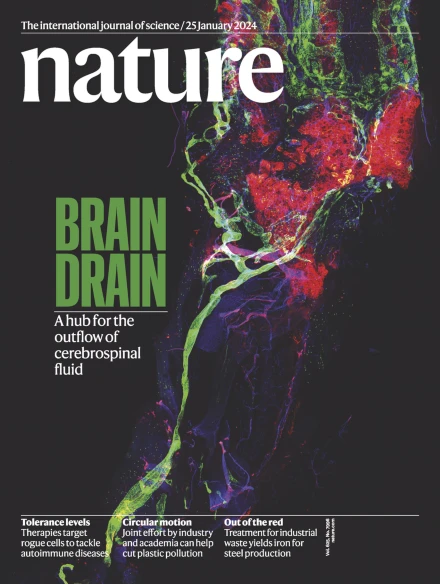植物中苯丙氨酸完全生物合成水杨酸。
IF 48.5
1区 综合性期刊
Q1 MULTIDISCIPLINARY SCIENCES
引用次数: 0
摘要
水杨酸(SA)是植物应对生物和非生物胁迫的关键激素。植物进化出两种产生SA的途径:异丙酸合成酶和苯丙氨酸解氨酶(PAL)途径1。虽然异氯酸酯合成酶途径已被完全确定2-4,但PAL途径仍不完整。本文通过对水稻SA缺陷基因1 (OSD1)至OSD4的功能分析,全面表征了SA生物合成的PAL途径。肉桂酰辅酶A (CoA)连接酶OSD1催化反式肉桂酸转化为肉桂酰辅酶A,肉桂酰辅酶A随后在过氧化物酶体中通过β-氧化途径转化为苯甲酰辅酶A。得到的苯甲酰辅酶a通过过氧化物酶体苯甲酰转移酶os2进一步转化为苯甲酸苄酯。苯甲酸苄酯随后被内质网膜细胞色素P450 OSD3羟基化为水杨酸苄酯,最终由细胞质羧酸酯酶OSD4水解为水杨酸。进化分析表明,PAL通路在裸子植物分化之前就已开始组装,并在大多数种子植物中保存。激活水稻PAL通路可显著提高水杨酸水平和植物免疫力。PAL途径的完成提供了跨植物物种的初级水杨酸生物合成途径的重要见解,并为调节作物免疫提供了精确的靶点。本文章由计算机程序翻译,如有差异,请以英文原文为准。
Complete biosynthesis of salicylic acid from phenylalanine in plants.
Salicylic acid (SA) is a pivotal phytohormone for plant responses to biotic and abiotic stresses. Plants have evolved two pathways to produce SA: the isochorismate synthase and phenylalanine ammonia lyase (PAL) pathways1. Whereas the isochorismate synthase pathway has been fully identified2-4, the PAL pathway remains incomplete. Here we report the full characterization of the PAL pathway for SA biosynthesis via functional analysis of rice (Oryza sativa) SA-DEFICIENT GENE 1 (OSD1) to OSD4. The cinnamoyl-coenzyme A (CoA) ligase OSD1 catalyses the conversion of trans-cinnamic acid to cinnamoyl-CoA, which is subsequently transformed to benzoyl-CoA via the β-oxidative pathway in peroxisomes. The resulting benzoyl-CoA is further converted to benzyl benzoate by the peroxisomal benzoyltransferase OSD2. Benzyl benzoate is subsequently hydroxylated to benzyl salicylate by the endoplasmic reticulum membrane-resident cytochrome P450 OSD3, which is ultimately hydrolysed to salicylic acid by the cytoplasmic carboxylesterase OSD4. Evolutionary analyses reveal that the PAL pathway was first assembled before the divergence of gymnosperms and has been conserved in most seed plants. Activation of the PAL pathway in rice significantly enhances salicylic acid levels and plant immunity. Completion of the PAL pathway provides critical insights into the primary salicylic acid biosynthetic pathway across plant species and offers a precise target for modulating crop immunity.
求助全文
通过发布文献求助,成功后即可免费获取论文全文。
去求助
来源期刊

Nature
综合性期刊-综合性期刊
CiteScore
90.00
自引率
1.20%
发文量
3652
审稿时长
3 months
期刊介绍:
Nature is a prestigious international journal that publishes peer-reviewed research in various scientific and technological fields. The selection of articles is based on criteria such as originality, importance, interdisciplinary relevance, timeliness, accessibility, elegance, and surprising conclusions. In addition to showcasing significant scientific advances, Nature delivers rapid, authoritative, insightful news, and interpretation of current and upcoming trends impacting science, scientists, and the broader public. The journal serves a dual purpose: firstly, to promptly share noteworthy scientific advances and foster discussions among scientists, and secondly, to ensure the swift dissemination of scientific results globally, emphasizing their significance for knowledge, culture, and daily life.
 求助内容:
求助内容: 应助结果提醒方式:
应助结果提醒方式:


